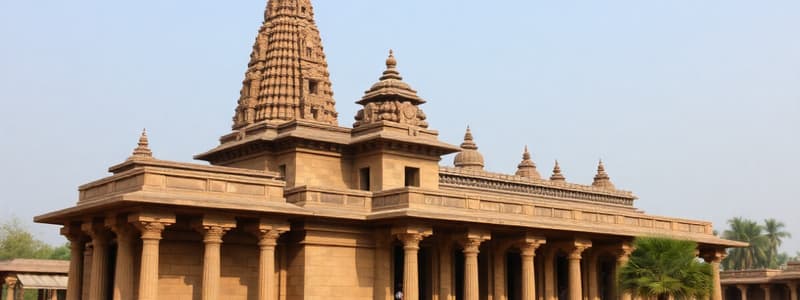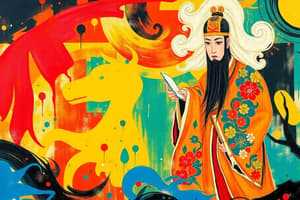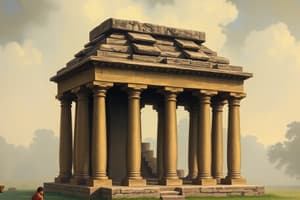Podcast
Questions and Answers
Which of the following is associated with the Chedi dynasty?
Which of the following is associated with the Chedi dynasty?
- Patronizing Patanjali's _Mahabhasya_
- Being founded by Simukha
- The Udayagiri caves and Hathigumpha inscription (correct)
- Construction of stupas at Sanchi and Barhut
What architectural innovation is attributed to the Satavahanas at Sanchi and Barhut?
What architectural innovation is attributed to the Satavahanas at Sanchi and Barhut?
- The original construction of the stupas
- The stone gateways or _toranas_ (correct)
- The carvings illustrating _Jataka_ tales without human figures
- The introduction of _shalbanjika_ sculptures
Which of these literary works is associated with the Sunga period?
Which of these literary works is associated with the Sunga period?
- Matsya Purana
- _Gathasaptasati_
- _Brihatkatha_
- _Malavikagnimitraim_ (correct)
What was a distinctive feature of Gautamiputra Satakarni's coinage?
What was a distinctive feature of Gautamiputra Satakarni's coinage?
Which material became particularly associated with Satavahana coinage?
Which material became particularly associated with Satavahana coinage?
What administrative division was known as 'Ahara' during the Satavahana period?
What administrative division was known as 'Ahara' during the Satavahana period?
Which of the following is a significant characteristic of Satavahana social structure?
Which of the following is a significant characteristic of Satavahana social structure?
What role did the 'Gandhikas' play in Satavahana society?
What role did the 'Gandhikas' play in Satavahana society?
Which of the following provided key insights into the Sunga Dynasty?
Which of the following provided key insights into the Sunga Dynasty?
What religious affiliation did King Kharavela of the Chedi dynasty hold?
What religious affiliation did King Kharavela of the Chedi dynasty hold?
Which style is characteristic of the rock-cut architecture during the Satavahana period?
Which style is characteristic of the rock-cut architecture during the Satavahana period?
Which of these languages was commonly used in inscriptions and official documents during the Satavahana rule?
Which of these languages was commonly used in inscriptions and official documents during the Satavahana rule?
Who assassinated the last ruler of the Sunga dynasty, Devabhuti?
Who assassinated the last ruler of the Sunga dynasty, Devabhuti?
What was the primary reason Rudra Daman I did not destroy the Satavahanas after defeating them?
What was the primary reason Rudra Daman I did not destroy the Satavahanas after defeating them?
Which of the following accurately describes the geographical spread of the Satavahana dynasty?
Which of the following accurately describes the geographical spread of the Satavahana dynasty?
Who founded the Satavahana dynasty after succeeding the Mauryas in the Deccan and central India?
Who founded the Satavahana dynasty after succeeding the Mauryas in the Deccan and central India?
Which city served as the capital of the Satavahana dynasty?
Which city served as the capital of the Satavahana dynasty?
What did the Sunga dynasty do to Stupas that were originally built by Ashoka?
What did the Sunga dynasty do to Stupas that were originally built by Ashoka?
During whose reign did the first native Indian kings issue their own coins with ruler's portraits?
During whose reign did the first native Indian kings issue their own coins with ruler's portraits?
What event is associated with Pushyamitra Sunga before he became the ruler of the Sunga dynasty?
What event is associated with Pushyamitra Sunga before he became the ruler of the Sunga dynasty?
Flashcards
Who was Pushyamitra Sunga?
Who was Pushyamitra Sunga?
Army chief of Brihadratha, founder of the Sunga Dynasty.
Capital of Sunga Dynasty
Capital of Sunga Dynasty
Pataliputra.
Sanchi and Barhut
Sanchi and Barhut
Stupas renovated during the Sunga period.
Agnimitra
Agnimitra
Signup and view all the flashcards
Devabhuti
Devabhuti
Signup and view all the flashcards
Satavahana Dynasty's Origin
Satavahana Dynasty's Origin
Signup and view all the flashcards
Simukha
Simukha
Signup and view all the flashcards
Early Satavahana Competitor
Early Satavahana Competitor
Signup and view all the flashcards
Capital of Satavahanas
Capital of Satavahanas
Signup and view all the flashcards
Satavahanas and Naval Power
Satavahanas and Naval Power
Signup and view all the flashcards
Satavahanas coins
Satavahanas coins
Signup and view all the flashcards
The perfumers
The perfumers
Signup and view all the flashcards
Ahara
Ahara
Signup and view all the flashcards
Kataka and Skandhavaras
Kataka and Skandhavaras
Signup and view all the flashcards
Satavahanas Architecture
Satavahanas Architecture
Signup and view all the flashcards
Temples Architecture
Temples Architecture
Signup and view all the flashcards
Vihara
Vihara
Signup and view all the flashcards
Satavahanas Language
Satavahanas Language
Signup and view all the flashcards
Satavahanas Book
Satavahanas Book
Signup and view all the flashcards
Hathigumpha inscription
Hathigumpha inscription
Signup and view all the flashcards
Study Notes
- These notes cover the Sungas and Satavahanas dynasties of ancient India, including their rulers, administration, art, and society.
Sunga Dynasty
- The founder of the Sunga Dynasty was Pushyamitra Sunga, a Brahmin army chief who assassinated Brihadratha.
- The capital was Pataliputra.
- Menander and Demetrius led attacks during this period.
- Stupas at Sanchi and Barhut, originally built by Ashoka, were renovated.
- Barhut is known for its Jataka tales, railings, and depictions of Yaksha and Yagni.
- Stone gates, or toranas, were added to Sanchi by the Satavahanas.
- Sanchi also features Vesantara Jataka stories.
- Shalbanjika, a Buddhist art element, depicts a woman or Yakshi often holding a tree, referencing Maya's birth of Buddha.
- Buddhist art during this time did not depict Buddha as a human figure.
- Buddhist sites included reliefs on stupas, featuring stylized females by trees, grasping or breaking branches like Buddha's mother Maya.
- Patanjali and his Mahabhasya were patronized.
- It is linked to ancient tree deities and fertility.
- Agnimitra, Pushyamitra's son, features as a hero in Kalidasa's poem "Malavikagnimitraim."
- Devabhuti was the last ruler, killed by minister Vasudev Kanva.
Chedi Dynasty
- The Chedi Dynasty existed around the 1st century BCE.
- It is also known as the Cheta or Mahameghavahana dynasty.
- Hathigumpha inscription provides information about this dynasty.
- King Kharavela engraved the Hathigumpha inscription and followed Jainism.
- Kharavela defeated Satakarni and was a Kalinga king.
- The Udayagiri caves, including the Ranigumpha cave, are a residence of Jain works.
- Jain Namokar Mantra and King Kharavela's military campaigns are associated with Udayagiri caves and the Hathigumpha inscription.
- Ranigumpha cave is double-storied and located in Udayagiri.
Satavahanas
- Simukha was the founder of the Satavahanas.
- The Satavahanas succeeded the Mauryas in the Deccan and central India.
- They are identified with the Andhras mentioned in Matsya and Vayu Purana.
- Early Satavahana territories included Maharashtra, later extending to Karnataka and Andhra.
- The Sakas were their greatest competitors.
- The title of the Satavahana rulers was Dakshinapata Pati.
- Gautami Putra Satakarni and Vasisthaputra Pulumayi were notable rulers.
- Rudra Daman I, a Shaka ruler of Saurashtra, defeated the Satavahanas twice but did not destroy them due to matrimonial alliances.
- Yajna Sri Satakarni was a lover of trade and navigation.
- Images of ships on coins reflect their engagement in trade.
- The Satavahanas were the first native Indian kings to issue coins with rulers' portraits, a practice started by Gautami Putra Satakarni.
- Their art and architecture are a fusion of local elements with northern ingredients.
- Ancient goldwork was sourced from Kolar fields.
- Coins were issued in lead, potin, bronze, and copper.
- They were known for cotton cultivation.
- The first rulers to grant land to Brahmans.
- Social organization included Gandhikas (perfumers, later shopkeepers) with the modern title of Gandhi.
- The Satavahana society was matrilineal, but the throne passed to male members.
- Districts were called Ahara.
Administration
- Officials included Amatyas and Mahamatras.
- Senapati served as provincial governors.
- Gaulmika was the head of rural administration.
- Kataka and Skandavaras were military camps and settlements.
- There were Buddhist monks and Brahmanas.
- The king or Raja had the right to strike coins.
- The administration included 3 grades of feudatories like Mahabhoja and Senapati.
Religion
- Brahmanas worshipped many Vaishnava gods.
- Buddhism, particularly Mahayana, flourished during their rule.
- Nagarjuna Konda and Amaravati were important seats of Buddhist culture.
Architecture
- Featured rock-cut architecture.
- Chaitya halls and Viharas (monasteries).
- Large temples with columns were built.
- Viharas served as residences for monks during the rainy season and were built in the Mauryan period.
- Examples include Karle Chaitya and Ellora caves.
Script & Language
- Prakrit was the official language.
- Brahmi script was used.
- There was a script & language.
Literature
- Gathasaptasati is attributed to Hala.
- Gunadhya composed Brihatkatha.
Studying That Suits You
Use AI to generate personalized quizzes and flashcards to suit your learning preferences.




